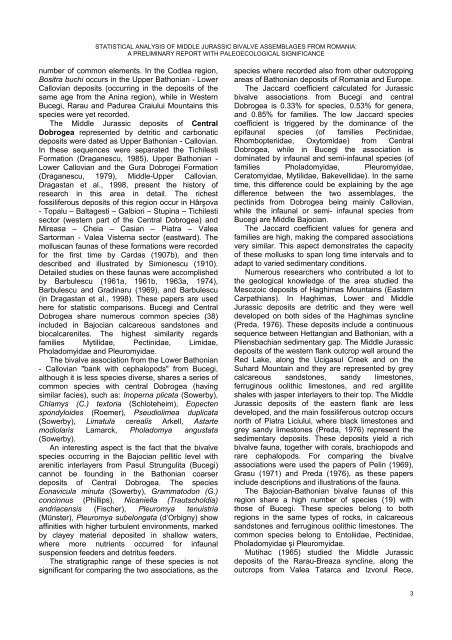statistical analysis of middle jurassic bivalve assemblages from
statistical analysis of middle jurassic bivalve assemblages from
statistical analysis of middle jurassic bivalve assemblages from
Create successful ePaper yourself
Turn your PDF publications into a flip-book with our unique Google optimized e-Paper software.
STATISTICAL ANALYSIS OF MIDDLE JURASSIC BIVALVE ASSEMBLAGES FROM ROMANIA:<br />
A PRELIMINARY REPORT WITH PALEOECOLOGICAL SIGNIFICANCE<br />
number <strong>of</strong> common elements. In the Codlea region,<br />
Bositra buchi occurs in the Upper Bathonian - Lower<br />
Callovian deposits (occurring in the deposits <strong>of</strong> the<br />
same age <strong>from</strong> the Anina region), while in Western<br />
Bucegi, Rarau and Padurea Craiului Mountains this<br />
species were yet recorded.<br />
The Middle Jurassic deposits <strong>of</strong> Central<br />
Dobrogea represented by detritic and carbonatic<br />
deposits were dated as Upper Bathonian - Callovian.<br />
In these sequences were separated the Tichilesti<br />
Formation (Draganescu, 1985), Upper Bathonian -<br />
Lower Callovian and the Gura Dobrogei Formation<br />
(Draganescu, 1979), Middle-Upper Callovian.<br />
Dragastan et al., 1998, present the history <strong>of</strong><br />
research in this area in detail. The richest<br />
fossiliferous deposits <strong>of</strong> this region occur in Hârşova<br />
- Topalu – Baltagesti – Galbiori – Stupina – Tichilesti<br />
sector (western part <strong>of</strong> the Central Dobrogea) and<br />
Mireasa – Cheia – Casian – Piatra – Valea<br />
Sartorman - Valea Visterna sector (eastward). The<br />
molluscan faunas <strong>of</strong> these formations were recorded<br />
for the first time by Cardas (1907b), and then<br />
described and illustrated by Simionescu (1910).<br />
Detailed studies on these faunas were accomplished<br />
by Barbulescu (1961a, 1961b, 1963a, 1974),<br />
Barbulescu and Gradinaru (1969), and Barbulescu<br />
(in Dragastan et al., 1998). These papers are used<br />
here for statistic comparisons. Bucegi and Central<br />
Dobrogea share numerous common species (38)<br />
included in Bajocian calcareous sandstones and<br />
biocalcarenites. The highest similarity regards<br />
families Mytilidae, Pectinidae, Limidae,<br />
Pholadomyidae and Pleuromyidae.<br />
The <strong>bivalve</strong> association <strong>from</strong> the Lower Bathonian<br />
- Callovian "bank with cephalopods" <strong>from</strong> Bucegi,<br />
although it is less species diverse, shares a series <strong>of</strong><br />
common species with central Dobrogea (having<br />
similar facies), such as: Inoperna plicata (Sowerby),<br />
Chlamys (C.) textoria (Schloteheim), Eopecten<br />
spondyloides (Roemer), Pseudiolimea duplicata<br />
(Sowerby), Limatula cerealis Arkell, Astarte<br />
modiolaris Lamarck, Pholadomya angustata<br />
(Sowerby).<br />
An interesting aspect is the fact that the <strong>bivalve</strong><br />
species occurring in the Bajocian pellitic level with<br />
arenitic interlayers <strong>from</strong> Pasul Strungulita (Bucegi)<br />
cannot be founding in the Bathonian coarser<br />
deposits <strong>of</strong> Central Dobrogea. The species<br />
Eonavicula minuta (Sowerby), Grammatodon (G.)<br />
concinnus (Phillips), Nicaniella (Trautscholdia)<br />
andriacensis (Fischer), Pleuromya tenuistria<br />
(Münster), Pleuromya subelongata (d’Orbigny) show<br />
affinities with higher turbulent environments, marked<br />
by clayey material deposited in shallow waters,<br />
where more nutrients occurred for infaunal<br />
suspension feeders and detritus feeders.<br />
The stratigraphic range <strong>of</strong> these species is not<br />
significant for comparing the two associations, as the<br />
species where recorded also <strong>from</strong> other outcropping<br />
areas <strong>of</strong> Bathonian deposits <strong>of</strong> Romania and Europe.<br />
The Jaccard coefficient calculated for Jurassic<br />
<strong>bivalve</strong> associations <strong>from</strong> Bucegi and central<br />
Dobrogea is 0.33% for species, 0.53% for genera,<br />
and 0.85% for families. The low Jaccard species<br />
coefficient is triggered by the dominance <strong>of</strong> the<br />
epifaunal species (<strong>of</strong> families Pectinidae,<br />
Rhombopteriidae, Oxytomidae) <strong>from</strong> Central<br />
Dobrogea, while in Bucegi the association is<br />
dominated by infaunal and semi-infaunal species (<strong>of</strong><br />
families Pholadomyidae, Pleuromyidae,<br />
Ceratomyidae, Mytilidae, Bakevellidae). In the same<br />
time, this difference could be explaining by the age<br />
difference between the two <strong>assemblages</strong>, the<br />
pectinids <strong>from</strong> Dobrogea being mainly Callovian,<br />
while the infaunal or semi- infaunal species <strong>from</strong><br />
Bucegi are Middle Bajocian.<br />
The Jaccard coefficient values for genera and<br />
families are high, making the compared associations<br />
very similar. This aspect demonstrates the capacity<br />
<strong>of</strong> these mollusks to span long time intervals and to<br />
adapt to varied sedimentary conditions.<br />
Numerous researchers who contributed a lot to<br />
the geological knowledge <strong>of</strong> the area studied the<br />
Mesozoic deposits <strong>of</strong> Haghimas Mountains (Eastern<br />
Carpathians). In Haghimas, Lower and Middle<br />
Jurassic deposits are detritic and they were well<br />
developed on both sides <strong>of</strong> the Haghimas syncline<br />
(Preda, 1976). These deposits include a continuous<br />
sequence between Hettangian and Bathonian, with a<br />
Pliensbachian sedimentary gap. The Middle Jurassic<br />
deposits <strong>of</strong> the western flank outcrop well around the<br />
Red Lake, along the Ucigasul Creek and on the<br />
Suhard Mountain and they are represented by grey<br />
calcareous sandstones, sandy limestones,<br />
ferruginous oolithic limestones, and red argillite<br />
shales with jasper interlayers to their top. The Middle<br />
Jurassic deposits <strong>of</strong> the eastern flank are less<br />
developed, and the main fossiliferous outcrop occurs<br />
north <strong>of</strong> Piatra Liciului, where black limestones and<br />
grey sandy limestones (Preda, 1976) represent the<br />
sedimentary deposits. These deposits yield a rich<br />
<strong>bivalve</strong> fauna, together with corals, brachiopods and<br />
rare cephalopods. For comparing the <strong>bivalve</strong><br />
associations were used the papers <strong>of</strong> Pelin (1969),<br />
Grasu (1971) and Preda (1976), as these papers<br />
include descriptions and illustrations <strong>of</strong> the fauna.<br />
The Bajocian-Bathonian <strong>bivalve</strong> faunas <strong>of</strong> this<br />
region share a high number <strong>of</strong> species (19) with<br />
those <strong>of</strong> Bucegi. These species belong to both<br />
regions in the same types <strong>of</strong> rocks, in calcareous<br />
sandstones and ferruginous oolithic limestones. The<br />
common species belong to Entoliidae, Pectinidae,<br />
Pholadomyidae şi Pleuromyidae.<br />
Mutihac (1965) studied the Middle Jurassic<br />
deposits <strong>of</strong> the Rarau-Breaza syncline, along the<br />
outcrops <strong>from</strong> Valea Tatarca and Izvorul Rece,<br />
3
















